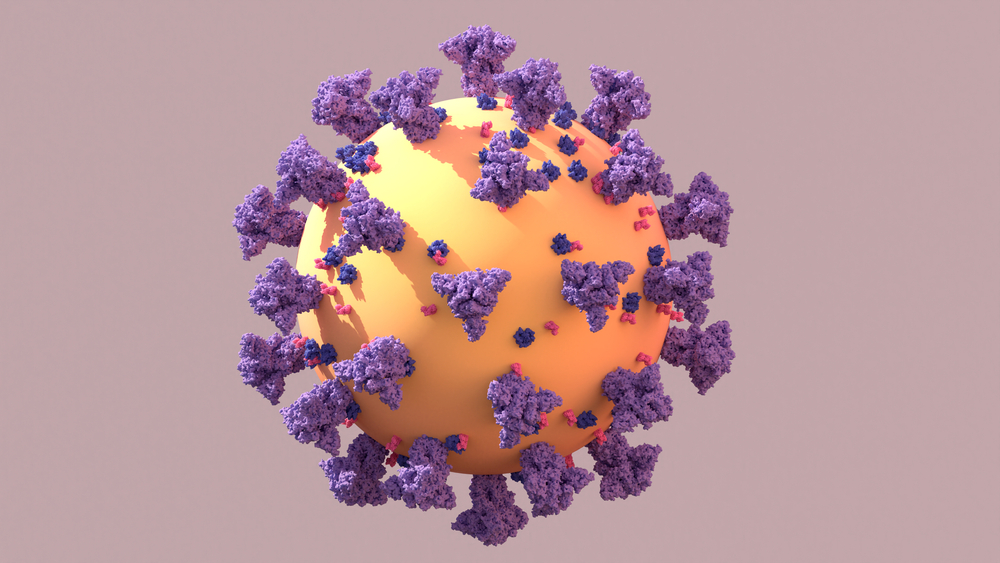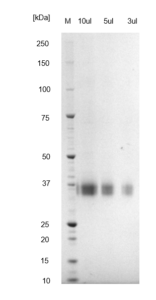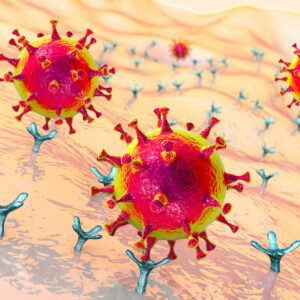SARS-CoV-2 Omicron BA.5 RBD, C-terminal His-tag
Price range: $691.59 through $2,635.97 excl. VAT
OMICRON VARIANT
SARS-CoV-2 (B.1.1.529/Omicron) Spike RBD (receptor binding domain) protein. Relative to Wuhan-Hu-1 this protein has following amino acid changes: G339D, S371L, S373P, S375F, K417N, N440K, G446S, S477N, T478K, E484A, Q493R, G496S, Q498R, N501Y, Y505H. Biotinylated protein also available. SARS-CoV-2, previously known as the 2019 Novel Coronavirus (2019-nCoV), causes the pandemic COVID-19 disease.
SARS-CoV-2 Omicron BA.5 Spike Glycoprotein RBD, His-Tag (HEK293)
SARS-CoV-2 (B.5/Omicron) Spike RBD (receptor binding domain) protein. Relative to Wuhan-Hu-1, this protein has following amino acid changes: G339D, S371F, S373P, S375F, T376A, D405N, R408S, K417N, N440K, L452R, S477N, T478K, E484A, F486V, Q498R, N501Y, Y505H. SARS-CoV-2, previously known as the 2019 Novel Coronavirus (2019-nCoV), causes the pandemic COVID-19 disease.
PRODUCT DETAILS – SARS-COV-2 (B.5/OMICRON) SPIKE GLYCOPROTEIN RBD, HIS-TAG (HEK293)
- SARS-CoV-2 (B.5/Omicron) spike RBD (Accession: GISAID EPI_ISL_12713186)
- SARS-CoV-2 (B.5/Omicron) RBD contains G339D, S371F, S373P, S375F, T376A, D405N, R408S, K417N, N440K, L452R, S477N, T478K, E484A, F486V, Q498R, N501Y, Y505H mutations relative to Wuhan Hu-1.
- Expressed in HEK293 and purified by affinity chromatography.
- Presented as liquid to high purity..
BACKGROUND
South Africa reported the identification of a new SARS-CoV-2 variant, B.1.1.529, to the World Health Organization (WHO) on November 24, 2021. B.1.1.529 was first detected in specimens collected in Botswana and South Africa. On December 1, 2021, the first case attributed to B.1.1.529 was reported in the United States in a person who returned from travel to South Africa. The Omicron variant has since been detected in travel-related cases in an increasing number of European countries, as well as Australia, Brazil, Canada, Hong Kong, Israel, Japan, Nigeria, Norway, Sweden, and the United Kingdom. A few countries, including the United States, have reported cases in individuals without travel history to southern Africa.
On November 26, 2021, the Technical Advisory Group on SARS-CoV-2 Virus Evolution (TAG-VE) convened to assess B.1.1.529. The TAG-VE advised WHO that this variant should be designated as a Variant of Concern (VOC), and WHO designated B.1.1.529 as a VOC named Omicron.
More recently, additional mutations in the BA.2 variant, variants BA.4 and BA.5, appear to have given transmissional advantage. BA.4 and BA.5 were first detected in South Africa in January and February 2022, respectively, where BA. 5 now accounts for more than half of the world’s cases, while BA. 4 just over one in ten (WHO Cronovirus Dashborad).
The World Health Organisation (WHO), in consultation with the Technical Group on Virus Evolution, have also designated BA. 4 and BA. 5 as variants of concern (VOC) (Tracking SARS-CoV-2 Variants, WHO).
REFERENCES
- Science Brief: Omicron (B.1.1.529) Variant (CDC).
- Classification of Omicron (B.1.1.529): SARS-CoV-2 Variant of Concern (WHO).
- Threat Assessment Brief: Implications of the emergence and spread of the SARS-CoV-2 B.1.1. 529 variant of concern (Omicron) for the EU/EEA



